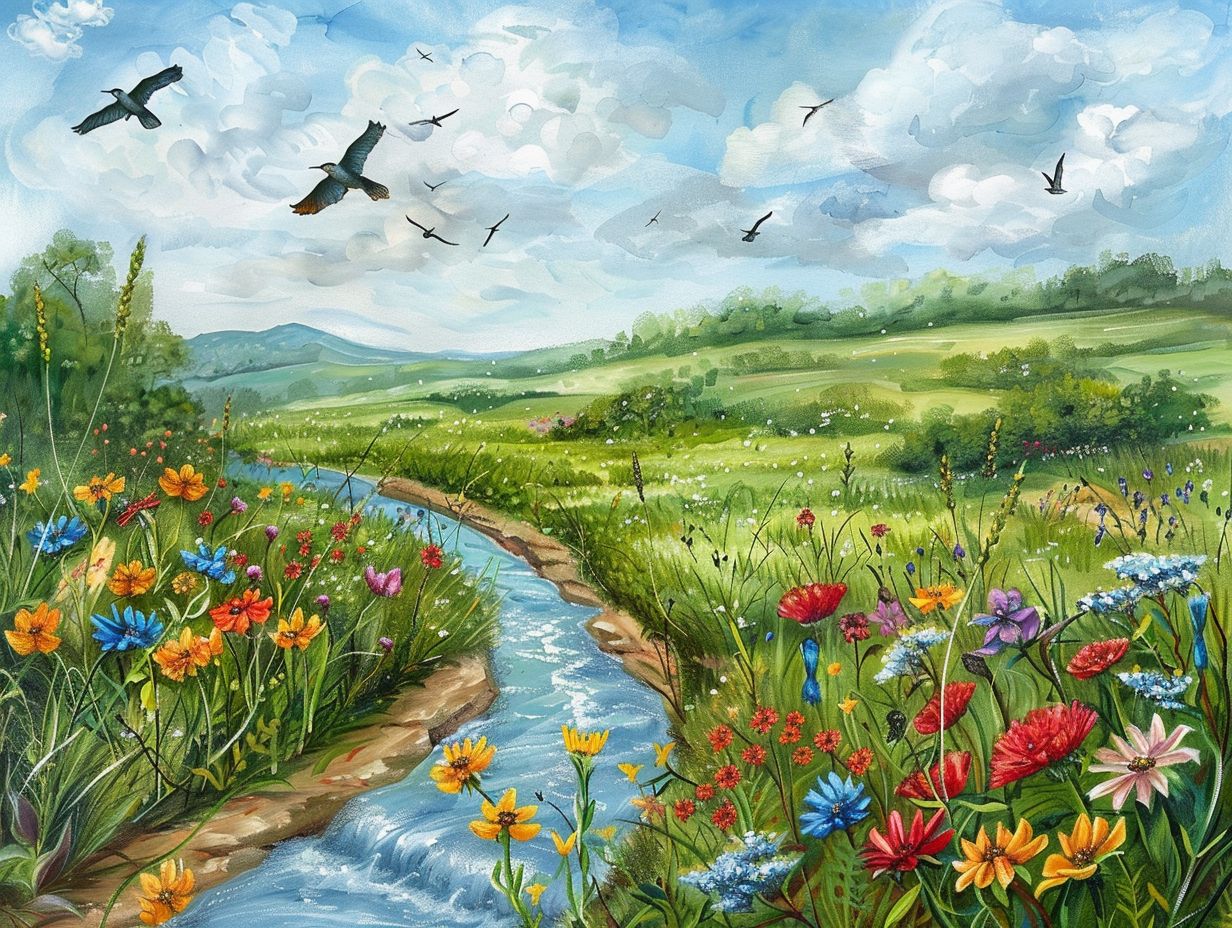Spring is a magical time to experience wildlife on hikes, and the UK offers some of the best locations to do just that. From the picturesque Lake District National Park to the rugged Snowdonia National Park, there are plenty of opportunities to spot birds, mammals, reptiles, insects, and wildflowers in their natural habitats.
If you’re eager to explore the great outdoors and encounter a variety of wildlife, these top UK hikes are a must-visit.
Key Takeaways:

- Spring is the best time to experience wildlife on hikes in the UK.
- The Lake District, South Downs, and Peak District National Parks are top picks for encountering diverse spring wildlife.
- Keep an eye out for birds, mammals, reptiles, amphibians, insects, and wildflowers on these hikes.
The Best UK Hikes for Experiencing Spring Wildlife
The United Kingdom provides a wide array of hiking trails that are well-suited for immersing oneself in the burgeoning wildlife of spring. From the tranquil scenery of the Lake District to the coastal cliffs of Pembrokeshire, each trail offers distinct vistas and the chance to behold the beauty of nature in springtime.
1. The Lake District National Park
The Lake District National Park, situated in Northern England, stands out as a prime destination for spring hikes, boasting stunning views, diverse wildlife, and a range of trails suitable for hikers of all skill levels.
During the spring season in the Lake District, vibrant colours of blooming flowers and the melodic sounds of birds singing add to the scenic beauty of the trails.
Explorations within the park may lead to encounters with emblematic wildlife, such as red squirrels, roe deer, and Herdwick sheep peacefully grazing in the picturesque surroundings.
Notable trails within the park include the Catbells route, renowned for its panoramic views of Derwentwater, and the challenging ascent up Helvellyn, one of the park’s highest peaks.
These trails offer not only physical challenges but also opportunities to delve into the rich historical heritage of the Lake District, with landmarks like ancient stone circles and charming villages scattered across the countryside.
2. The South Downs National Park
The South Downs National Park is esteemed for its rolling hills, abundant biodiversity, and picturesque paths that provide hikers with an opportunity to witness the lively wildlife of spring in a peaceful and scenic environment.
The park offers an extensive network of paths suitable for hikers of all proficiency levels, encompassing options that range from leisurely walks to more demanding excursions. While walking through the varied landscapes, one should remain attentive to the plentiful wildlife inhabiting this region, including skylarks, hares, and butterflies.
During the spring season, the park becomes adorned with a profusion of wildflowers, creating a colourful and fragrant backdrop amidst the lush surroundings. The South Downs showcases distinctive features such as ancient woodlands, chalk grasslands, and stunning viewpoints, ensuring that each walk is a noteworthy and memorable experience.
3. The Peak District National Park

The Peak District National Park represents a picturesque and historically significant region within the United Kingdom that serves as an ideal setting for springtime hiking excursions. This location boasts a diverse array of landscapes, abundant wildlife, and a network of trails that cater to a wide range of hiking abilities, varying from leisurely strolls to more challenging treks.
Hikers exploring the Peak District are presented with an assortment of trails, including the renowned Pennine Way, which affords breathtaking vistas of the undulating terrain. The park’s ecosystem supports a rich biodiversity, with notable species such as red deer, mountain hares, and a variety of bird species inhabiting the area.
During your exploration of the park, you may encounter rare plant species, such as orchids and wild garlic, adding to the allure of the natural environment. Enthusiasts of history will find interest in visiting prominent landmarks like the ancient Roman thoroughfare known as the Batham Gate or the Roman fort located at Brough.
The Peak District’s diverse topography, which encompasses rugged moorlands and idyllic valleys, renders it a captivating destination year-round. Late spring and early autumn emerge as particularly favoured periods for visitors to experience the park’s splendour.
4. The Cairngorms National Park
The Cairngorms National Park in Scotland presents a rugged and diverse terrain that harbours unique wildlife and provides exceptional opportunities for spring hikes. The park features trails that traverse through some of the most awe-inspiring landscapes in the United Kingdom.
This national park is widely recognised for its demanding hiking paths, such as the Lairig Ghru route. This route meanders through the heart of the Cairngorms, offering breathtaking views of the towering mountains and ancient Caledonian forests.
Enthusiasts of wildlife may have the chance to observe red deer, golden eagles, and ptarmigan during their journey, creating an immersive experience in nature. With its rugged charm and varied ecosystems, the Cairngorms National Park serves as an ideal destination for adventurous hikers seeking to challenge their abilities amidst the dramatic Scottish scenery.
5. The Norfolk Coast Path
The Norfolk Coast Path is a coastal trail renowned for its breathtaking sea views, abundant wildlife, and the opportunity to explore the unique coastal ecosystem during the vibrant spring season.
As individuals traverse along this picturesque path, they will be treated to an array of coastal wildlife sightings, including seals sunbathing on sandy beaches, diverse seabirds gracefully soaring overhead, and occasional glimpses of elusive otters frolicking in the shallows.
In addition, the trail is adorned with a variety of plant species, such as colourful wildflowers like sea lavender and sea aster, which enhance the coastal landscape with vibrant hues.
Throughout their journey, hikers will encounter historic landmarks like the imposing ruins of St. Mary’s Priory, offering insights into the rich historical tapestry of the region.
6. The Pembrokeshire Coast Path
The Pembrokeshire Coast Path is a remarkable coastal trail situated in Wales, providing hikers with an opportunity to immerse themselves in the beauty of dramatic cliffs, diverse wildlife, and breathtaking seascapes, making it an ideal selection for spring hiking excursions.
As individuals traverse the path, they may encounter a diverse array of seabirds including puffins, razorbills, and guillemots, which nestle along the rugged cliffs.
The azure waters below often accommodate seals either basking on rocky outcrops or frolicking in the gentle surf. Beyond the natural allure, the path features historical landmarks such as ancient castles and picturesque fishing villages that offer insights into the region’s historical narrative.
While certain segments of the path are relatively straightforward to traverse, others present more demanding terrain, catering to hikers of varying skill levels.
7. The Snowdonia National Park
Snowdonia National Park in Wales is widely recognised for its rugged mountains, abundant biodiversity, and challenging trails that provide hikers with the opportunity to immerse themselves in the splendour of spring wildlife amidst some of the most striking landscapes in the United Kingdom.
The park features an extensive network of varied hiking trails that cater to outdoor enthusiasts of all skill levels. From gentle paths meandering through verdant valleys to strenuous climbs up renowned peaks like Snowdon, there is a trail suitable for every individual.
Enthusiasts of wildlife will be enthralled by the chance to observe rare species such as mountain goats, peregrine falcons, and red squirrels within the park’s boundaries. The flora of the park is equally enthralling, exhibiting a diverse array of plant species that are indigenous to the region.
The awe-inspiring scenery encompasses cascading waterfalls, tranquil lakes, and expansive panoramas that will inspire profound admiration for the grandeur of nature even among seasoned hikers.
8. The Northumberland National Park
The Northumberland National Park is a tranquil and picturesque destination that provides a selection of paths where walkers can immerse themselves in the sights and sounds of spring wildlife, set against the backdrop of rolling hills and significant historical landmarks.
The park boasts a varied range of wildlife, including red squirrels, otters, and various bird species such as curlews and lapwings. Nature lovers have the chance to enjoy the plentiful flora, with colourful wildflowers decorating the landscape during the spring season.
For history enthusiasts, the ancient ruins of Hadrian’s Wall, acknowledged as a UNESCO World Heritage Site, act as a glimpse into the park’s rich historical heritage. Walkers are offered a variety of path options, varying in difficulty from gentle walks to more challenging routes that provide stunning views of the surrounding countryside.
What Wildlife Can You Expect to See on These Hikes?

Whilst partaking in spring hikes throughout the United Kingdom, individuals can expect to encounter a wide range of wildlife. This includes numerous species of birds, mammals, reptiles, amphibians, insects, and wildflowers. Each of these elements contributes significantly to the abundant biodiversity and aesthetic appeal of the landscape.
1. Birds
Spring provides an optimal opportunity for engaging in birdwatching activities during hikes, as numerous avian species make their return from migration, engaging in activities such as nest building, singing, and foraging for food amidst the verdant landscapes.
Noteworthy avian species to be on the lookout for during springtime hikes in the United Kingdom include the Robin, Blackbird, Blue Tit, Chaffinch, and Song Thrush.
Prominent trails that offer exceptional birdwatching experiences include the Norfolk Coast Path, the Peak District National Park, and the Isle of Mull.
The early hours of the morning and the late hours of the afternoon are particularly conducive for birdwatching, as birds tend to exhibit heightened activity levels during these intervals.
For effectively identify avian species, it is recommended to attentively listen for their distinctive calls, observe their colouration patterns, and take note of their size and morphology.
It is advisable to equip oneself with binoculars, a comprehensive field guide, and a notebook for the purpose of documenting and cataloguing avian sightings.
2. Mammals
Mammals exhibit increased activity during the spring season, presenting an opportune moment for hikers to observe species such as deer, foxes, and rabbits engaged in foraging and tending to their offspring amidst the revitalised surroundings.
Spring excursions within the UK offer nature enthusiasts the chance to directly encounter the burgeoning wildlife. Prominent trails like the South Downs Way and the Peak District National Park are renowned for their rich variety of mammalian inhabitants.
Optimal viewing opportunities for these animals are heightened during the early morning or twilight hours when many mammals are most active.
It is advisable to maintain a vigilant watch for movements within dense foliage or open meadows, and to ensure a respectful distance is upheld to facilitate observation without causing disruption to their natural behaviours.
3. Reptiles and Amphibians
Spring hikes provide a unique opportunity to observe a variety of reptiles and amphibians, including snakes, lizards, frogs, and newts, as they emerge from hibernation and become active in the warmer weather.
These creatures inhabit diverse habitats, with snakes often frequenting rocky outcrops or grassy areas, while lizards tend to favour sunny locations for basking, such as rocks or fallen logs.
Frogs are commonly found near ponds or marshy regions, their distinctive croaks resonating during the breeding season. On the contrary, newts typically reside in damp woodlands and moist meadows. Optimal times to encounter these elusive species are mornings or late afternoons, particularly when exploring trails adjacent to water sources or within wooded areas.
4. Insects
Spring heralds a surge in insect activity, with butterflies, bees, and other pollinators becoming more conspicuous as they fulfil essential roles in the ecosystems bordering hiking trails. These insects are integral to pollinating plants and ensuring the propagation of diverse flora in these environs.
As hikers traverse trails in the spring season, they are likely to encounter species such as the resplendent Monarch butterfly, the diligent honeybee, and the bustling bumblebee. Some of the most promising trails for observing insect activity encompass wooded areas with varied plant life and open meadows adorned with vibrant wildflowers.
Enthusiasts keen on identifying distinct insect species would find it advantageous to carry a field guide or utilise a nature application to aid in the identification of the assorted butterflies, bees, and other insects that may be present.
5. Wildflowers
One of the notable features of spring hikes is the profusion of blooming wildflowers, which contribute vibrant hues and aromatic fragrances to the surroundings while also attracting a variety of pollinators.
In the UK, spring hikes often showcase bluebells, primroses, and wild daffodils. Among the recommended trails for observing wildflowers is the South Downs Way, where hikers can witness striking exhibitions of orchids and cowslips.
These pathways typically flourish from April through June, presenting a magnificent spectacle set against the verdant expanses of meadows and woodlands. Excelling in diverse habitats such as woodlands, meadows, and coastal cliffs, wildflowers offer hikers manifold opportunities to admire their aesthetic appeal.
Tips for Spotting Wildlife on Hikes

Observing wildlife during hiking excursions can provide a gratifying experience. By adhering to a few straightforward guidelines, such as maintaining silence, moving at a gradual pace, and utilising binoculars, hikers can heighten their chances of encountering a diverse array of species in their natural environments.
For optimise the wildlife observation adventure, it is crucial to comprehend behavioural cues exhibited by animals, such as tracks, scat, and vocalisations.
Additionally, it is beneficial to consider the timing of the hiking expedition, as the periods of dawn and dusk are particularly conducive to wildlife activity. Prior research into optimal locations renowned for specific species, such as water sources or meadows, can also enhance the experience.
Respecting wildlife is paramount. This entails maintaining a safe distance, refraining from feeding the animals, and avoiding any disruptions to their habitats. It is advisable to carry a field guide for assistance with species identification, and safety should always be prioritised for both the observer and the wildlife.
Frequently Asked Questions
What are the best UK hikes for experiencing spring wildlife?
The best UK hikes for experiencing spring wildlife include the South West Coast Path, the Lake District National Park, the Cairngorms National Park, the Norfolk Coast Path, the Pembrokeshire Coast Path, and the Northumberland Coast Path.
What types of wildlife can be seen on these hikes?
On these hikes, you can see a variety of spring wildlife such as birds, butterflies, wildflowers, deer, and even dolphins and whales along the coast.
When is the best time to go on these hikes for wildlife viewing?
Spring is the best time to go on these hikes for wildlife viewing as it is when many animals are coming out of hibernation and migrating back to their summer habitats.
Are there any guided hikes available for experiencing spring wildlife in the UK?
Yes, there are several guided hikes available for experiencing spring wildlife in the UK. These can be found through local tour companies or through national parks and nature reserves.
What should I bring on these hikes for the best wildlife experience?
It is recommended to bring binoculars, a camera, a field guide, and appropriate clothing and footwear for the weather conditions. It is also important to respect the wildlife and their habitats by not feeding or disturbing them.
Are there any safety precautions to keep in mind while hiking for spring wildlife?
Yes, it is important to be aware of any potential hazards such as steep cliffs, unpredictable weather, and wildlife that may behave unpredictably. It is also recommended to inform someone of your hiking plans and to stay on designated trails.

